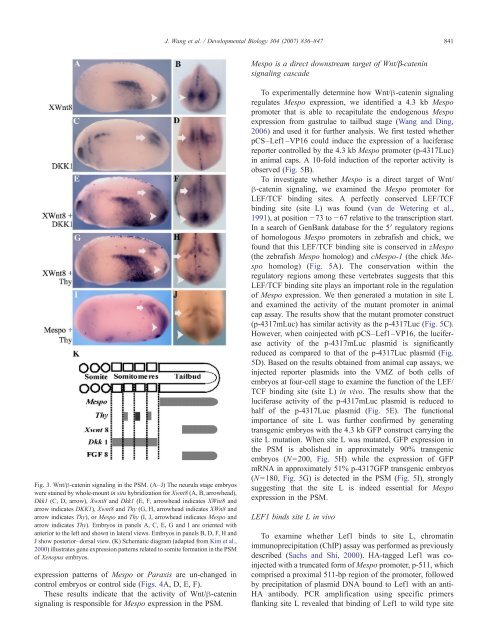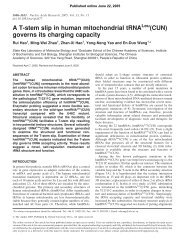2007-DevelopmentalBiology.pdf
2007-DevelopmentalBiology.pdf
2007-DevelopmentalBiology.pdf
You also want an ePaper? Increase the reach of your titles
YUMPU automatically turns print PDFs into web optimized ePapers that Google loves.
Fig. 3. Wnt/β-catenin signaling in the PSM. (A–J) The neurula stage embryos<br />
were stained by whole-mount in situ hybridization for Xwnt8 (A, B, arrowhead),<br />
Dkk1 (C, D, arrow), Xwnt8 and Dkk1 (E, F, arrowhead indicates XWnt8 and<br />
arrow indicates DKK1), Xwnt8 and Thy (G, H, arrowhead indicates XWn8 and<br />
arrow indicates Thy), or Mespo and Thy (I, J, arrowhead indicates Mespo and<br />
arrow indicates Thy). Embryos in panels A, C, E, G and I are oriented with<br />
anterior to the left and shown in lateral views. Embryos in panels B, D, F, H and<br />
J show posterior–dorsal view. (K) Schematic diagram (adapted from Kim et al.,<br />
2000) illustrates gene expression patterns related to somite formation in the PSM<br />
of Xenopus embryos.<br />
expression patterns of Mespo or Paraxis are un-changed in<br />
control embryos or control side (Figs. 4A, D, E, F).<br />
These results indicate that the activity of Wnt/β-catenin<br />
signaling is responsible for Mespo expression in the PSM.<br />
J. Wang et al. / Developmental Biology 304 (<strong>2007</strong>) 836–847<br />
Mespo is a direct downstream target of Wnt/β-catenin<br />
signaling cascade<br />
To experimentally determine how Wnt/β-catenin signaling<br />
regulates Mespo expression, we identified a 4.3 kb Mespo<br />
promoter that is able to recapitulate the endogenous Mespo<br />
expression from gastrulae to tailbud stage (Wang and Ding,<br />
2006) and used it for further analysis. We first tested whether<br />
pCS–Lef1–VP16 could induce the expression of a luciferase<br />
reporter controlled by the 4.3 kb Mespo promoter (p-4317Luc)<br />
in animal caps. A 10-fold induction of the reporter activity is<br />
observed (Fig. 5B).<br />
To investigate whether Mespo is a direct target of Wnt/<br />
β-catenin signaling, we examined the Mespo promoter for<br />
LEF/TCF binding sites. A perfectly conserved LEF/TCF<br />
binding site (site L) was found (van de Wetering et al.,<br />
1991), at position −73 to −67 relative to the transcription start.<br />
In a search of GenBank database for the 5′ regulatory regions<br />
of homologous Mespo promoters in zebrafish and chick, we<br />
found that this LEF/TCF binding site is conserved in zMespo<br />
(the zebrafish Mespo homolog) and cMespo-1 (the chick Mespo<br />
homolog) (Fig. 5A). The conservation within the<br />
regulatory regions among these vertebrates suggests that this<br />
LEF/TCF binding site plays an important role in the regulation<br />
of Mespo expression. We then generated a mutation in site L<br />
and examined the activity of the mutant promoter in animal<br />
cap assay. The results show that the mutant promoter construct<br />
(p-4317mLuc) has similar activity as the p-4317Luc (Fig. 5C).<br />
However, when coinjected with pCS–Lef1–VP16, the luciferase<br />
activity of the p-4317mLuc plasmid is significantly<br />
reduced as compared to that of the p-4317Luc plasmid (Fig.<br />
5D). Based on the results obtained from animal cap assays, we<br />
injected reporter plasmids into the VMZ of both cells of<br />
embryos at four-cell stage to examine the function of the LEF/<br />
TCF binding site (site L) in vivo. The results show that the<br />
luciferase activity of the p-4317mLuc plasmid is reduced to<br />
half of the p-4317Luc plasmid (Fig. 5E). The functional<br />
importance of site L was further confirmed by generating<br />
transgenic embryos with the 4.3 kb GFP construct carrying the<br />
site L mutation. When site L was mutated, GFP expression in<br />
the PSM is abolished in approximately 90% transgenic<br />
embryos (N=200, Fig. 5H) while the expression of GFP<br />
mRNA in approximately 51% p-4317GFP transgenic embryos<br />
(N=180, Fig. 5G) is detected in the PSM (Fig. 5I), strongly<br />
suggesting that the site L is indeed essential for Mespo<br />
expression in the PSM.<br />
LEF1 binds site L in vivo<br />
To examine whether Lef1 binds to site L, chromatin<br />
immunoprecipitation (ChIP) assay was performed as previously<br />
described (Sachs and Shi, 2000). HA-tagged Lef1 was coinjected<br />
with a truncated form of Mespo promoter, p-511, which<br />
comprised a proximal 511-bp region of the promoter, followed<br />
by precipitation of plasmid DNA bound to Lef1 with an anti-<br />
HA antibody. PCR amplification using specific primers<br />
flanking site L revealed that binding of Lef1 to wild type site<br />
841







